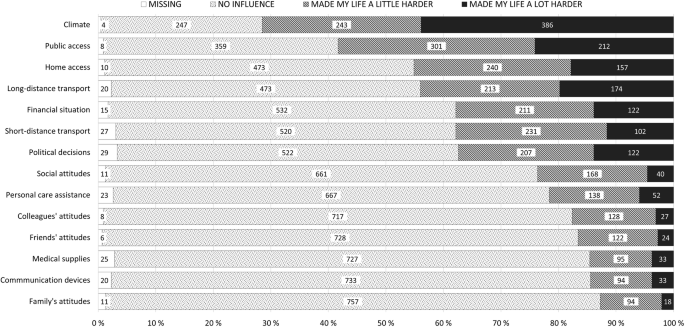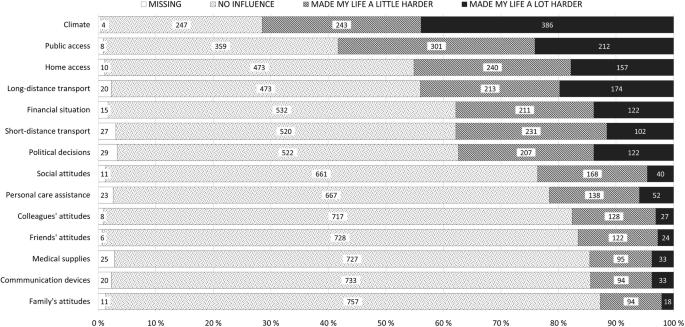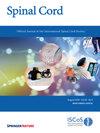芬兰脊髓损伤患者感知到的环境障碍:横断面调查。
IF 2.1
4区 医学
Q3 CLINICAL NEUROLOGY
引用次数: 0
摘要
对芬兰脊髓损伤(SCI)患者进行横断面调查。调查芬兰脊髓损伤患者认为会增加参与难度的环境障碍(EB)的频率,并比较不同性别、年龄、受伤时间和损伤严重程度的环境障碍发生率。研究人员从负责芬兰 SCI 患者终身护理的三家 SCI 门诊诊所的登记册中招募参与者。在芬兰脊髓损伤研究(FinSCI)(n = 1772)中收集的自填式诺特威尔环境因素调查简表(NEFI-SF)被用于调查。使用了非参数检验和多项式逻辑回归模型。共有 880 人回答了 NEFI-SF 项目(回答率为 50%)。72%的受访者认为气候是一个障碍,44%的受访者认为气候是一个严重障碍。59%和 24%的受访者认为公共交通是障碍,46%和 18%的受访者认为私人住宅是障碍,45%和 20%的受访者认为长途交通是障碍。每 10 位受访者中就有 4 位表示,资金、缺乏短途交通辅助设备以及政治决策限制了他们的参与。伤势较重的受访者的 NEFI-SF 总分更高(意味着他们认为 EB 受到的限制更多)。气候、进入公共和私人场所、交通挑战、财务和政治决策是芬兰SCI患者最常认为限制其参与的环境因素。大多数限制因素都是可以改变的。提高建筑环境的无障碍性、为所有人提供平等服务以及积极的特殊待遇,都可以减少其影响。本文章由计算机程序翻译,如有差异,请以英文原文为准。


Environmental barriers perceived by the Finnish population with spinal cord injury: a cross-sectional survey
Cross-sectional survey of the Finnish population with spinal cord injury (SCI). To explore the frequencies of perceived environmental barriers (EB) that made participation harder for the Finnish population with SCI and to compare the occurrence of perceived EBs by gender, age, time since injury, and injury severity. Participants were recruited from the registers of the three SCI outpatient clinics responsible for the lifelong care of people with SCI in Finland. The self-administered Nottwil Environmental Factors Inventory Short Form (NEFI-SF) collected in the Finnish Spinal Cord Injury Study (FinSCI) (n = 1772) was used. Nonparametric tests and multinomial logistic regression models were utilized. 880 individuals responded to the NEFI-SF items (response rate 50%). Climate was perceived as a barrier by 72% and a serious one by 44% of the respondents. The rates regarding public access were 59% and 24%, private home access 46% and 18%, and long-distance transport 45% and 20%. Four out of ten respondents reported that finances, lack of assistive devices for short-distance transport, and political decisions restricted their participation. The NEFI-SF total scores were higher (meaning more perceived restrictions by EBs) for those more severely injured. Climate, access to public and private places, challenges with transport, finances, and political decisions were the EBs most frequently perceived to restrict participation by the Finnish population with SCI. Most EBs that were prominent causes of restrictions are modifiable. Greater accessibility to the built environment, equal services to all, and positive special treatment could reduce their effects.
求助全文
通过发布文献求助,成功后即可免费获取论文全文。
去求助
来源期刊

Spinal cord
医学-临床神经学
CiteScore
4.50
自引率
9.10%
发文量
142
审稿时长
2 months
期刊介绍:
Spinal Cord is a specialised, international journal that has been publishing spinal cord related manuscripts since 1963. It appears monthly, online and in print, and accepts contributions on spinal cord anatomy, physiology, management of injury and disease, and the quality of life and life circumstances of people with a spinal cord injury. Spinal Cord is multi-disciplinary and publishes contributions across the entire spectrum of research ranging from basic science to applied clinical research. It focuses on high quality original research, systematic reviews and narrative reviews.
Spinal Cord''s sister journal Spinal Cord Series and Cases: Clinical Management in Spinal Cord Disorders publishes high quality case reports, small case series, pilot and retrospective studies perspectives, Pulse survey articles, Point-couterpoint articles, correspondences and book reviews. It specialises in material that addresses all aspects of life for persons with spinal cord injuries or disorders. For more information, please see the aims and scope of Spinal Cord Series and Cases.
 求助内容:
求助内容: 应助结果提醒方式:
应助结果提醒方式:


